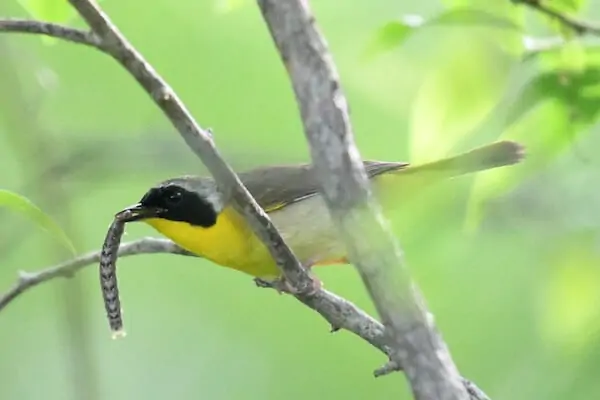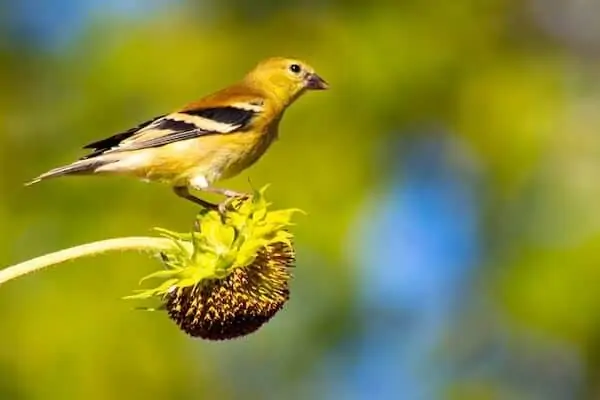Attracting birds to your yard is simple with bird feeders and bird baths. It isn’t, however, the only way! The kinds of birds that visit your yard will be determined by the plants, trees, and shrubs you have around your home.
Native plants provide food as well as protection, including seeds, insects, and berries. Birds are on the lookout for the following: hiding places from predators, seeking refuge from the elements, and appropriate nesting habitat. As a result, let’s look at what attracts birds to a plant, as well as several specific instances of plants.
WHY DO PLANTS ATTRACT BIRDS
What attracts birds to a plant? Food and shelter are the most basic needs!
1. SHELTER
Creating sheltered areas for birds requires dense foliage, twiggy shrubs, thick brambles, and evergreen leaves. Your backyard bird pals are just as cautious about inclement weather as we are. These covered perching sites can be found in any yard with a few trees and shrubs. Birds can also avoid predators like hawks by living close by. Many birds, especially during the breeding season, prefer to construct their nests in areas with heavy cover to keep their offspring safe from the elements and predators.
2. INSECTS
Because they primarily eat insects, many birds will be unable to attract with a seed feeder. To attract these bug-loving birds to your yard, you’ll need to include some insect-friendly plants.
Some common insectivorous birds are
- Bluebirds
- Wrens
- Phoebes
- Swallows
- Kingbirds
- Flycatchers
- Warblers
- Vireos
The birds that visit your birdfeeder will also benefit from the insects. Insects (particularly caterpillars) are used as the primary food source for seed-eating birds’ nestlings, and they will supplement their diet with them. As a result, you can make your yard a much more appealing choice for creating a nest and raising children by including plants and trees that caterpillars like. Cardinals, chickadees, grosbeaks, orioles, titmice, and woodpeckers are some of the common feeder birds that eat insects as well.
3. SEEDS
The birds were doing just fine finding seeds on their own before humans provided simple access to seed at bird feeders. You may readily provide seed by having a few seed-bearing plants. Having plants in your yard that provide a variety of seeds can attract more bird species, even if you use a bird feeder.
Some seed-eating and grain-eating birds are granivorous (granivorous birds)
- Sparrows
- Finches
- Siskins
- Juncos
- Redpolls
- Doves
- Grosbeaks
- Buntings
4. FRUIT
Sugar, which is a valuable energy source and desired by many birds, is found in fruits. Oranges, apples, raspberries, and cherries are some of the fruits that we humans might consume, but there are several kinds of berries that we would never eat. While it is cold and other food is scarce, certain fruiting plants species are able to continue producing fruit into the winter months, which provides an important source of energy.
Fruit-loving common backyard birds include:
- American Robins
- Orioles
- Waxwings
- Gray Catbirds
- Northern Mockingbirds
- Tanagers
Let’s examine some common plant species that may provide excellent food and shelter possibilities for the birds in your yard now that we understand what they are looking for. Always plant only what is native to your region, as we always recommend.
6 TYPES OF TREES THAT ATTRACT BIRDS

1. OAKS
Some caterpillars and other insects eat Oaks trees. Insect-loving birds will find this beneficial foraging terrain. Acorns are an important winter food source for many forest birds, and fall oak trees produce them. Acorn fans include woodpeckers, blue jays, nuthatches, and titmice. Because of their bulk branches, broad leaves, and tough wood, oak trees provide excellent cover and nest cavities.
2. WILD CHERRY
Wild cherry trees burst with blossoms in the spring, attracting insects that birds devour. Hummingbirds can also be found feeding on their spring blooms. Several kinds of fruit-loving birds later consume the cherry fruit throughout the summer. Many caterpillars live in these trees, which are a vital source of food for numerous birds.
3. MAPLE
Another favorite of wild birds is maples, which are also excellent trees for nesting and provide food for insects. The bark of maple is more delicate than that of some other woodland trees, providing a softer surface for sap and insect probing woodpeckers. Hundreds of caterpillar species live in maples. Maples create samaras (I call them helicopters!) in the spring, which provide food for a variety of birds, including grosbeaks and cardinals.
4. FLOWERING DOGWOOD
The lovely spring blooms attract insects (and hummingbirds), and the birds follow the bugs. In the autumn, many birds flock to flowering dogwood for its red fruit. I’m sure our local bluebirds and robins love seeing flowering dogwood in my yard.
5. AMERICAN HOLLY
Holly trees are large, robust, and live for a long time. As a result, the holly tree becomes a sought-after refuge for birds during bad weather. It’s also a perfect location for nest construction since it’s protected and safe. Hollies are chosen for nesting by northern cardinals and robins. Holly berries, which develop in the fall and winter, offer sustenance later into the year than many other trees because they only develop on female plants.
6. AMERICAN BEECH
More caterpillars than practically any other tree are known to live in this species. Caterpillars are frequently fed to newly hatched young, and they are extremely important to breeding birds. Many warblers, vireos, and tanagers will flock to the beech as a result of this. Many birds, including the yellow bellied sapsucker, like the beechnuts and their sap in the autumn.
9 COMMON SHRUBS & BUSHES THAT ATTRACT BIRDS

1. AMERICAN ELDERBERRY
Elderberry is a great yard choice for attracting birds. Many insects flock to its blooms, which provide excellent foraging opportunities for birds. The purple clusters of berries it generates in the late summer, however, are its most distinguishing feature. Birds like these berries a lot.
2. JUNIPER
For backyard birds, juniper is a excellent shrub. These are evergreens, and their cover protects them from the cold and wind all winter long. Birds nest in the spring under the cover of junipers. Throughout the winter, their waxy blue berries are accessible, which is an significant food source during Lean Seasons. (note: pollinated females only create berries)
3. ARROWOOD VIBURNUM
This plant’s white blooms attract insects in the spring. It produces black berries that birds like in the late summer/early autumn. For borders, or as a hedge row, this is a great shrub.
4. SERVICEBERRY
The popularity of serviceberry as a wildbird attracting plant has long been recognized. Many insects are attracted to the white blooms of the spring. It develops small reddish-purple fruits that are particularly succulent, sweet, and nutritional in late spring and early summer. The birds prefer these over ripe ones, and they pick them off the bush before they can be completely mature!
5. BLACKBERRY & RASPBERRY
Both you and the birds can benefit from fruiting shrubs! Many insects are drawn to these shrubs, which makes them ideal bird hunting grounds. They prefer to grow in enormous tangled brambles, which provide a favored nesting and hiding place for many birds. They also absolutely adore those yummy berries.
6. NORTHERN BAYBERRY
The silvery colored berries of barberrys are present year-round, making them a semi-evergreen shrub. They provide excellent cover and nesting sites, in addition to a dependable supply of fruit.
7. STAGHORN SUMAC
In the autumn, the staghorn sumac produces both seeds and fruit for wild birds, with gorgeous vibrant red leaves. It can provide a food source throughout the winter months because it is fall fruiting.
8. WINTERBERRY
This shrub, like the holly tree, belongs to the holly family and offers a variety of benefits. It’s hardy, gives excellent cover, and the berries continue to be a major food source throughout the winter.
9. VIRGINIA CREEPER
Although this vine resembles poison ivy, it won’t harm you. During the winter, many birds benefit from the fruit produced by Virginia Creeper.
7 TYPES OF FLOWERS THAT ATTRACT BIRDS

Flowers may attract songbirds by bringing more insects to the yard and producing seeds that are consumed by numerous species, while we might believe of flowers attracting hummingbirds by providing nectar.
1. SUNFLOWER
The monarch of the seed kingdom is these huge and stunning blossoms. For their nutritional benefits, sunflower seeds are one of the greatest and most commonly used seeds in birdseed mixes.
2. PURPLE CONEFLOWER
These lovely blooms will attract pollinators and butterflies, and in the fall their seeds will attract finches and other birds.
3. CORNFLOWER
Birds and insects both like cornflower. Pollen, nectar, seeds, and sap are all present.
4. BLACK-EYED SUSAN
Black-eyed susans, which produce seeds that tiny birds like chickadees and finches enjoy, are a yard favorite for many.
5. ZINNIA
Many gardeners save zinnia seeds for future re-planting after collecting them towards the conclusion of the season. Sparrows and finches love to eat these lovely blooms, which produce a lot of seeds.
6. ASTER
Asters produce seeds that are appealing to many little birds, and they create a delicate purple color late in the season.
7. MARIGOLD
Your summer garden will be brightened by these long-blooming flowers. Many insects are attracted to marigolds, which will attract a variety of insect-loving birds. In their zeal to locate the bugs, blackbirds and other bigger birds may occasionally trample and rip up the flowers.
ADDITIONAL LANDSCAPING IDEAS TO ATTRACT BIRDS
A freshly maintained lawn is a biological desert, according to something I heard once. While most birds desire a flawlessly wide expanse of green grass, that flawless lawn is a dead end for most owners. Lawns have no fruits or flower nectar, and other than worms, they have few insects since they aren’t allowed to grow tall enough to produce seeds.
You may want to consider letting a few parts of your lawn go wild, even if you don’t want to give up a well-kept grass for an untamed jungle. The rear yard is often less accessible to passers-by than the front yard for many residences. In the front, you might keep conventional grass, but in the rear, natural lawn like clover or violets would take control. More insects will be attracted by native plants and weeds.
Edges should be redesigned. Could you instead plant some shrubs or native flowers in place of a foot or two of lawn on the property’s edges or in a far corner? Leave some leaf litter in the form of a few stick piles.
